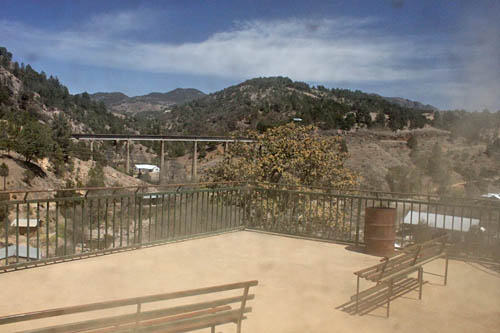By day nine, I was totally under the spell of Entre Amigos Hostel in Urique. I knew that If I didn’t leave soon I might stay forever, and there was so much more of Mexico’s Copper Canyon to see. Sadly, I packed my bag and hopped aboard the 7:30 a.m. bus to Bahuichivo, where I would catch another bus to Creel, the eastern gateway to the canyon.
I opted for the local bus rather than El Chepe, the famous train that runs through the canyon, for a couple of reasons. First, it was cheap. While the fare on the first class train would have cost in excess of $900 pesos ($75 USD), the bus fare was a mere $140 pesos ($11.50 USD). And since the most spectacular views on the train ride occur on the portion of the route I had traveled nine days earlier, scenery was no reason to splurge. Second, the bus leaves Bahuichivo at 11 a.m. and gets to Creel around 2:30 p.m., well ahead of the train. Since I was traveling without reservations during the popular Semana Santa (Easter Week) holiday, I needed to get to Creel to lock up accommodations before El Chepe spewed its passengers on the town.

The bus from Urique deposited me in front of Super Valdez, the largest market in Bahuichivo. Thirty minutes later, an ancient white school bus ground to a halt and the driver hopped out to load our luggage. As he heaved open the heavy rear door a cloud of putty-colored dust billowed out. Choking, he disgustedly swept one hand through the mountain of dust until, realizing the futility of his action, he shrugged and loaded our luggage on top of the remaining dust.
After making sure that my bag was loaded I hurried on board. All of the windows were cracked open at the top, having long ago lost the ability to close entirely, and dust had pervaded every centimeter of the interior, coating the green vinyl seats and black floors. Near the back of the bus I grabbed a seat next to a window that seemed a bit less dusty than the rest and shoved my backpack on the floor between my legs.
Gears ground as we descended the hill, crossed the railroad tracks, and headed into the canyon. Our hot shot driver sped around blind curves on a washboard dirt track barely wide enough for one vehicle, slamming on the brakes and creeping to the edge whenever oncoming traffic appeared. The road wound back and forth over a boulder-strewn stream, crossing dozens of rickety one-lane bridges. Clouds of suffocating dust infiltrated every crack. Floorboards rattled. Windows rattled. My teeth rattled. Larger bumps in the road sent me flying out of my seat and crashing back down again. Alarmed, I picked up my backpack and set it on my lap, hoping that the rough ride hadn’t damaged my laptop.

Two hours later, as the road widened and began a gradual climb out of the canyon, the driver pulled to the side of the road and stopped in the middle of nowhere to collect the fare. Little old ladies plucked whole rolls of toilet paper from their purses and headed down the hill, in search of a rock or a tree that would provide enough privacy to do their business. Men walked a few feet from the bus, turned their backs to the passengers, and let loose. With all that jouncing around, I definitely needed a bathroom break, but I refused to squat in clear view of a bus full of people. I’d just have to hold it.

Soon afterward we turned right onto a brand new paved highway. Curious, I inquired where the road to the left went. “To Bahuichivo,” said one of the passengers. “Then why did the bus take the dirt road?” Apparently, the new highway was built for the mines and it bypasses all the villages where the bus picks up passengers. A few minutes later we pulled into the town of San Rafael, where we changed to a modern coach, since the remainder of the trip would be on improved roads.

Desperately in need of a bathroom, I made for the tiny store that doubled as a bus station while our luggage was transferred. Behind a decrepit wooden door, an old toilet basin, sans seat, shared space with mops and buckets, but when I pulled open the door a woman behind the counter stopped me. “No funciona.” It’s not working. Panicked, I asked what was wrong with it. “No agua.” There had been no water available in this town for several days. “Pero lo necessito!” I said, alarmed. I really need it. The woman scrutinized me for several anxious seconds before asking, “Pee pee?” “Yes, only pee pee!” I promised in Spanish. The door scraped the floor and refused to close all the way, but I was beyond caring. I squatted over the filthy bowl and balanced my pack on my back while trying to keep my pants legs from dragging on the wet floor, grateful to have access to a bathroom – any bathroom. And then I ran for the bus.

Before I knew it, we were in Creel. I reclaimed my dusty suitcase, smacked as much dirt as possible out of my black pants, ran my fingers through my caked and matted hair, and went in search of Casa Margarita’s Hostel. I was lucky. There was one bed left in the dorm. I snatched it up for $100 pesos (~$8.50 USD), a price that included breakfast and dinner. A couple of hours later I was feeling pretty good about my decision to take the bus as I sat in the dining room of the hostel and watched dozens of recently arrived train passengers being turned away. Little did I know that they were the lucky ones. I would soon discover that Casa Margarita was the hostel from hell.
To be continued…..
